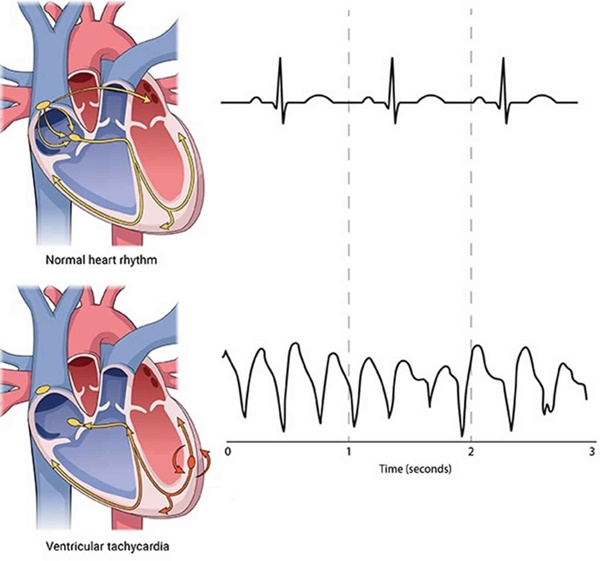Cardiac arrhythmias can appear for the following reasons, the electrical impulse is not appropriately generated, originates in the wrong place, or the paths for electrical conduction are altered.
Ventricular fibrillation
Causes
The heart’s electrical activity is disorganised in this arrhythmia, so there is no effective beat. This situation systematically leads to severe cardiac arrest, which, if cardiac resuscitation cannot be stopped, is irreversible and causes death.
People who suffer from it
This type of arrhythmia occurs mainly in patients with heart disease and, especially, has involvement in the coronary arteries, and the arrhythmia may be its first manifestation. Exceptionally, ventricular fibrillation can also occur in patients who only have a disorder of the electrical properties of the heart. They are usually young patients, and, in most cases, a genetic component has been found, so it is not uncommon for these patients to have a family history of sudden unexplained death.
Among the most well-known electrical abnormalities that can cause sudden death due to ventricular fibrillation, it is worth highlighting:
- Congenital long QT syndrome is a hereditary disease in which episodes of ventricular tachycardia occur, generally short and self-limited, which can degenerate into ventricular fibrillation. It can manifest itself from childhood and is characterised by episodes of loss of consciousness that are usually triggered by emotional situations or effort. The diagnosis is generally made from the baseline electrocardiogram (ECG), although this may be practically normal in some cases. Family history can help make the diagnosis. Some forms of this syndrome can be accompanied by congenital deafness.
- Brugada syndrome. It is a hereditary familial disease in which affected patients may present repeated syncope and sudden death. The definitive diagnosis is given by the ECG, which presents some characteristic alterations. In patients with this syndrome, the ECG may be transiently normal. In these cases, if there is clinical suspicion, the diagnosis can be made by performing a drug test that can reveal the ECG alteration.
Treatment
Acute episodes of ventricular fibrillation (VF): This is a vital emergency in which cardiopulmonary resuscitation manoeuvres must be started immediately, including cardiac massage, ventilation and urgent cardiac defibrillation.
- Chronic VF treatment: In the VF treatment approach, whether the VF is due to a specific cause must be established. Thus, for example, in some patients, the VF episode occurs during the myocardial infarction. In these cases, only myocardial infarction should be treated. In all other situations, since the possibility of recurrence and, therefore, sudden death is very high, an implantable cardioverter-defibrillator should be indicated, which, although it will not prevent new VF crises from occurring, will allow them to be treated promptly. Immediate and automatic, preventing the patient from dying.
Paroxysmal supraventricular tachycardia (PSVT)
Causes
These are episodes of tachycardia that usually start suddenly without any specific trigger, although it can sometimes start with exercise or bending over. The attacks can vary, ranging from minutes to several hours. They usually stop spontaneously and abruptly, although sometimes medical assistance is required to prevent tachycardia, either through some manoeuvre or drugs.
Symptoms
The symptoms are rapid and regular palpitations, although syncope, chest pain or other discomforts may occasionally occur. In addition, there is a specific type of PSVT in which patients report a localised throbbing sensation in the neck.
People who suffer from it
It is not uncommon for the patient to have been diagnosed with a nervous breakdown. These tachycardias can occur at any age and can be found in newborns to the elderly. It is not usually associated with any other cardiac disorder or abnormality.
Diagnosis
The ECG outside the seizures is normal, except for an anomaly that is the Wolff-Parkinson-White syndrome, in which an abnormality is detected in the ECG even without tachycardia. In other cases, an electrophysiological study should be performed if an ECG is not recorded during the crisis.
Treatment
Most acute PSVT crises resolve spontaneously after several minutes. If they persist, some type of treatment should be considered. The first measure that must be tried to stop a problem is the so-called vagal manoeuvres. Intravenous antiarrhythmic treatment should be administered if the tachycardia does not subside despite this.
Prevention
Patients who have presented a PSVT crisis usually present recurrences. To avoid this, there are two therapeutic alternatives:
- Antiarrhythmic drugs must be administered continuously; they are only effective 50 per cent of the time and can have side effects.
- Radiofrequency ablation: in this type of tachycardia, given its high effectiveness (90 per cent) and low frequency of complications.
Ventricular Tachycardia (VT)
People who suffer from it
They originate in the ventricle and often occur in patients with heart disease but can occasionally occur in healthy people.
Symptoms
The symptoms that can cause VT can be highly variable. Thus, they can be completely asymptomatic, manifest only with palpitations; or give more severe symptoms such as dizziness, sweating, syncope, or sudden death.
